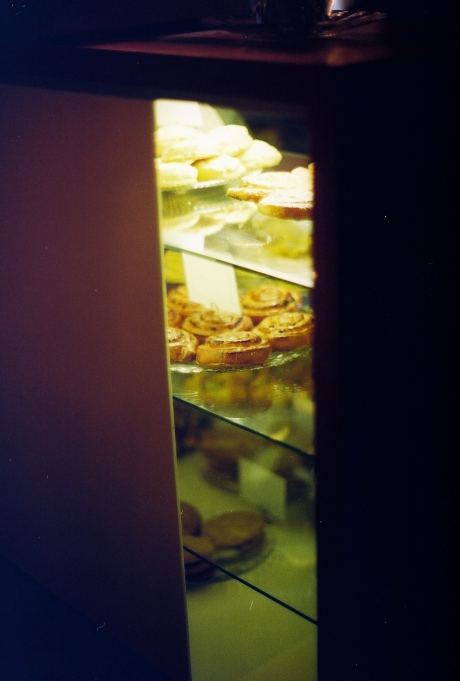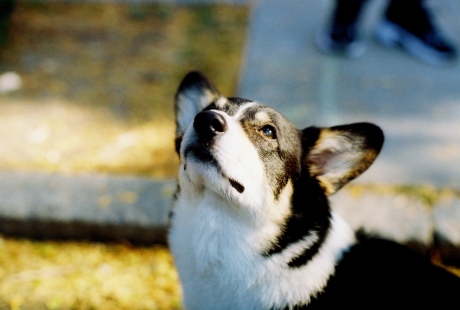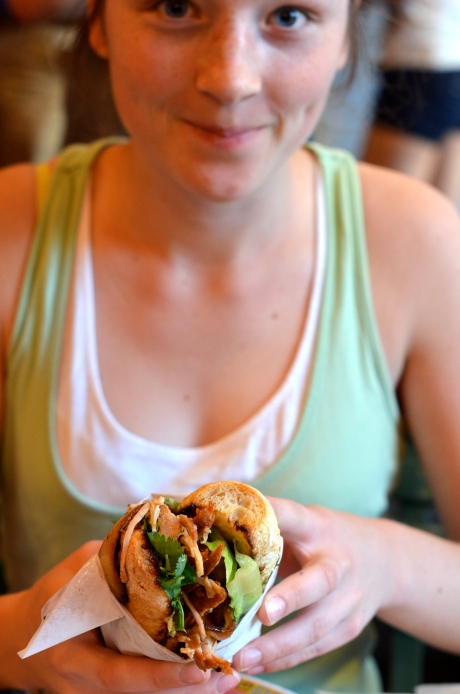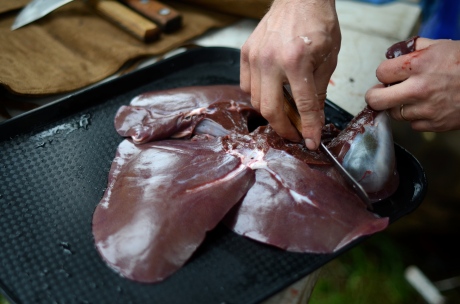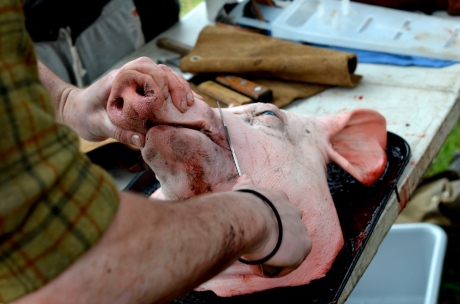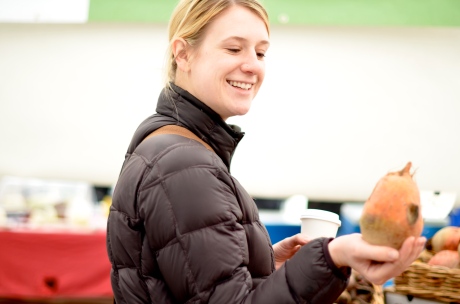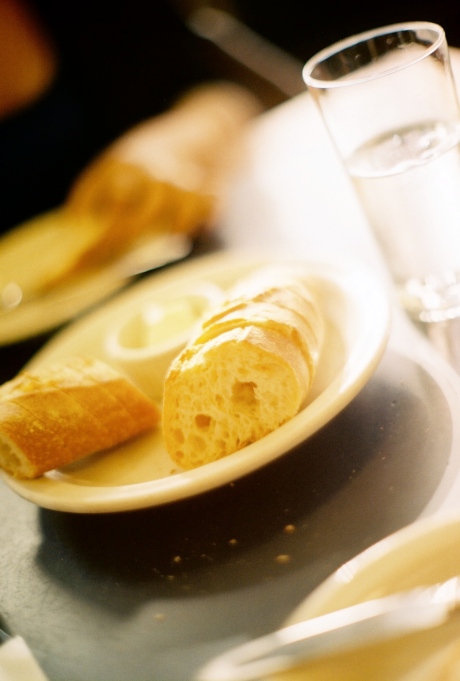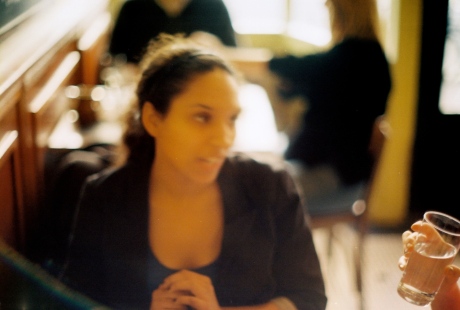Part 1 and Part 2
Five days later, I’m back on Vashon, after a 7 am wakeup and 8 am ferry, driving south on the main road, going way past the tiny little town and the turnoff for the farm where the pigs were raised and slaughtered. The road curves through the ferns and mossy trees and pops out along the eastern coast where it clings to the rocky little shore for a half-mile or so. The highway heads back into the trees and I almost miss the turnoff to the Farmstead Meatsmith headquarters, a big A-frame house that they’ve only just moved in to. The raised living room and bright sunroom serve as a makeshift butcher shop. Today every surface will become home to pork products: the dining room table is covered in white paper, the stainless steel prep table in the sunroom is covered with wooden cutting boards. The best surface of all is the incredibly solid butchers block that Brandon got from some woman in Reno who got it from her dad, who got it from a closing grocery store. He’s got the old-school three pound cleaver to go along with it—the woman of the butcher block ran after him with it, not wanting to separate the block and the knife after so many intimate decades together.

There are six of us today—two middle-aged Seattle guys who want to keep it real in the city and have big charcuterie plans. Another two have come in from farms near Port Townsend, and are dressed in that way that young farmers dress, in holey shirts and practical pants, leaving a little trace of dirt clinging on everything as a badge of honor. One, a girl with rimless glasses, is in the middle of raising eight (“Eight?” Andrew asks then tries not to look too shocked) pigs on the farm she works for, and is here to really learn what to do with them. The other farmer is just about to be a father, and has plans to live with no income in a little house near the sea, working on the farm for produce and collecting oysters from the ocean. And raising pigs.
Sometimes I think of myself farming, spending a summer working on some little organic farm, sleeping in a farmhouse and eating what I’ve picked—then I meet farmers and I realize that I am a sissy little girl and I like croissants and cozy beds. I’ve volunteered on a couple of those sweet little organic farms and it was not sweet. It was novel for about 35 minutes, then I was just squatting in the dirt and getting bit by ants and sweating.
And one other classmate, a woman from Bellingham who’s preparing for the apocalypse. She’ll be the one who can kill the pigs and provide the pork chops in the midst of the collapse of civilization, she said, and I don’t think there was that much kidding. And why am I here, in my white shirt and yoga pants, possibly the worst outfit choice for cutting up a pig. Because I’m a little-bit-lost college grad trying to find something interesting to do, and I feel like I’ve poked around in lots of aspects of food and this is one area that I’ve missed. Because, mostly because, it’d be cool to butcher a pig.

We go outside to the “USDA certified slaughter truck” and start hauling the pig sides in. Three halves of the pigs killed last weekend come in from the truck—one half is saved for the charcuterie class in a few days. The dining table gets a whole pig, the silver prep table a half. We all naturally find our pig half and start fondling knife handles, anxious to start. We start by quartering the pig: the leg, the shoulder, the belly, and the loin (the back.) There are already some recognizable cuts—you can see the stripes that will become bacon on the exposed side of the belly, the leg looks like prosciutto, the ribs; pork chops to-be. And it’s hard work, butchery, transitioning from knife to saw, knife to saw—slicing carefully through flesh and sawing frustratedly through bone—and it’s wholly satisfying. There are things that feel especially good, especially tactile and right, like peeling the skin off the belly, wedging your thumbnail in-between the soft fat and the harder fat that lies just underneath the skin, peeling it off in a thick white waxy layer.

Cutting the spare ribs off the belly is nice too, carefully picking the knife in-between the bone and the fat, hugging the bone with the blade to keep as much fat on the belly—on the bacon—as possible as you cut the ribs away. The loin gets gently pulled out from under the spine by hand. The pork chops are hard to do and I swear off of them after doing only one. They stand in a row, all attached, and have to be first sliced, then cleavered apart. The slicing, fine. The cleaver action, terrifying. I do one shoddily and slink away, hands shaking a little. The shoulder gets cut in half, into the picnic and the Boston Butt, cuts I’ve heard of and seen wrapped in saran wrap, but would never have been able to point out on the pig. The thick legs become roasts, hams if they’re brined. I realize that that bony little circle that’s so good for gnawing is the pig’s real-live leg bone, not just decoration. The feet come off, the back one sawed and the front one just kind of worked off, a knife pushed through all the connective tissue till suddenly I had a little pig paw in my palm. There are different ways to cut up the animal; the American cuts generally symmetrical, with no consideration of bones or curves. The French cuts work more closely with the way the animal is built, Brandon says. He explains that as much as they do their best to let the pigs be pigs when they’re alive, they want them to be able to be pigs when they’re dead too. There’s no sense in making difficult cuts that the flesh and bones don’t want you to make. We finally finish the pigs, after three hours of cutting and sawing and peeling and pulling and pushing.
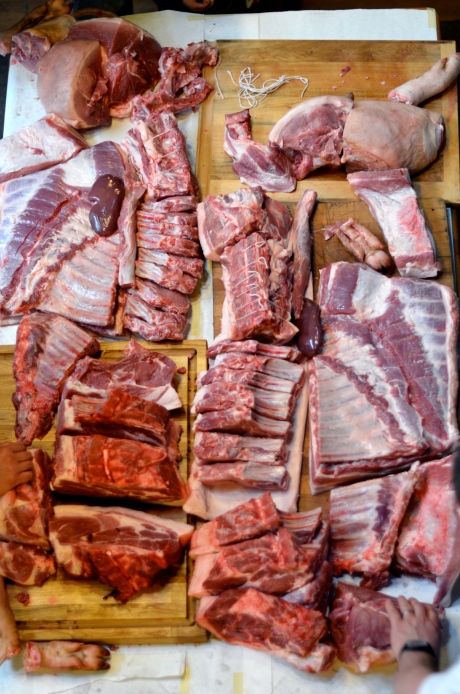
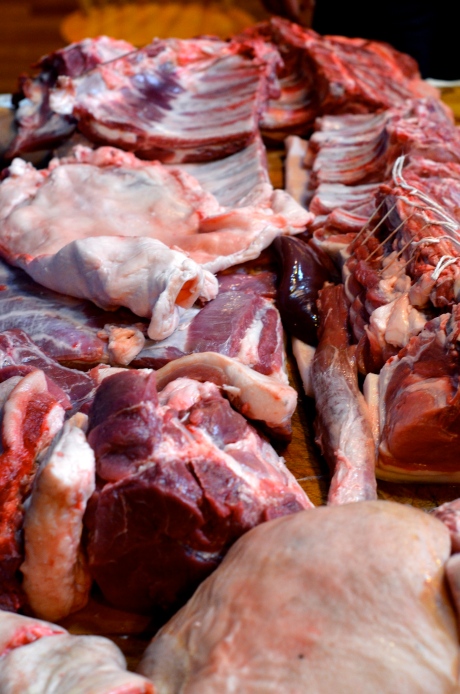
Andrew’s been in the kitchen the whole time, making lunch, and I’ve been peeking over the whole time, almost more interested in what he’s making that smells so good than the animal in front of me. Our final task before lunch is reassembling the pieces, putting them back together into a pig. It’s harder than it sounds—the original position of the pieces forgotten after we successfully divided them from the rest of the body. But the dining room table soon holds a Franken-pig, all its pieces shuffled back together in a close-enough way. Each half gets heaped into a bus bucket and we clear the table for lunch.

We have brown bread, baked while we butchered, spread with soft sweet butter and sprinkled with salt, while we wait for the hunk of pork to finish roasting, a sirloin roast, a cut I don’t think I’ve ever had before. When it finally gets pulled out of the oven its inch and a half of fat is browned and crackling, dripping its essence backs down into the meat. We fill up plates with hot potato gratin, the top crisped like the pig skin, cauliflower dressed with ribbons of balsamic reduction, and a raw salad of kale, apples, carrots, and cabbage, a welcome crisp freshness next to the fats and carbs and heavy, now very familiar, protein. I sit next to Wallace, Brandon’s two and a half year old son and we talk about what we do and don’t like. “Do you like the meat?” he asks me with his adorable little man cuteness, “I do, do you?” He grins and chews on a crispy little piece of skin. “Do you like carrots?” he asks me, and when I say yes he takes a little orange piece out of his mouth and offers it to me, “This one is really good.” I ask him what he likes to do and he says, “Eat!” and pops a little piece of fat into his mouth. Brendan and his family are way more comfortable with fat than most of us. He worships pig fat, reluctant to lose even an ounce. The difficult process of scalding and scraping preserves precious back fat; the butchering techniques leaves no fat behind. Andrew has followed suit—I see him squish big slices of fat onto bread like butter. It is good fat, and I do try a bit of the fat I’ve been fondling for the past three hours, but one bite is enough—it takes practice to eat that much pork.

After lunch I wash my hands, but they wont really get clean, they’re so saturated with fat. They feel smooth and they look a little shiny, and I strongly shove lurking germ fears away. Waiting in line to get on the ferry back to Seattle, I look through my pictures, making my way backwards from butchery back to evisceration, scraping, hanging, dragging, killing—all the way to photos of three live pigs rooting around a their familiar dirt, Brandon and Andrew’s hands rubbing their heads. “The first step in any pig recipe,” Brandon had said when he got ready to kill the pigs. The butchery was difficult and interesting, the bones and muscles no longer really animal. The organs were vaguely gross but mostly fascinating. The killing was the most uncomfortable part, watching something slump into something else entirely, its systems breaking apart and becoming materials–but those pigs had been raised for pork their whole lives. Their birth was the first step in the pig recipes; in the bacon and eggs, in the seared loin medallions, in the creamy pate to be slathered on good bread. Most of all, these two days showed the incredible amount of work that goes into meat. If all pigs were raised, killed, and processed in this way, pork would be astronomically expensive. So there’s ways now to raise them and kill them and turn them into meat for far, far less money.
And I think it’s interesting that we’re wanting to go back to the slow, painful, expensive way. Farmstead Meatsmith put out a video about butchery last summer, On The Anatomy of Thrift, and it got over 25 thousand hits. And it’s not a video for old farmers just sorting out the internet—it’s for young people in cities wanting to get a taste of that oldness, of this trend of simplification. It’s tempting to belittle this trend—the obsession with the artisan, the hand-made, the curated vintage—and call it just a trend. But I think it comes out of a really complex desire, some weird need that our culture is developing as we forge onward. I think its comes from something deeper than trendiness—we can feel a need for change in our world. The earth is crowded and tired. We have been going upward for ages, and I think maybe we’re needing a little break. But it’s not possible to put civilization on hold while we all move to the woods and start raising pigs and kale. So we’re funneling that slow-down, good ol’ days desire into things like food and shopping—things that are both enjoyable and easy to change. Choosing local apples, buying a handmade bag from a local shop, going out to a farm to watch a pig get killed and helping butcher it by hand—these kinds of things let us feel that we’re slowing down, even if we’re not. Andrews’s blog describes itself: “We intend to serve the needs of the burgeoning agrarian renaissance by producing dynamic media for agricultural enterprises and organizations.” And this is why this neo-back-to the land thing is so interesting. Because it seems like it’s a turning away from technology, from all that’s modern and progressive, but we can’t really leave all that behind, can’t forsake our iPhones for hatchets. Like me, most people wouldn’t last long on a farm. So, instead, we’re blogging about pigs.


